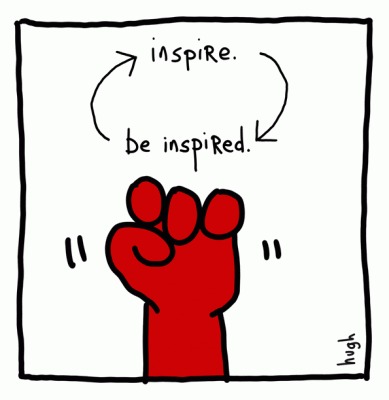Happy new year, everyone! (that is, if you are inclined to follow that particular calendar…)
Have you, like me, been reading some of the predictions on what is and what is not going to happen this year? What buzzwords to remember, which ones to avoid? What to focus at, where to “pivot” to, what to ignore?
 One of the predictions I read was that social media has lost its sizzle. Markets saturated with products, failed to live up to the lofty ideas of monetising it, done, begone… Now that is, of course, the prediction of either someone who looks only what seems investable by Sandhill Road this quarter (and by that notion, he is probably correct) and/or someone who forgets that one actually doesn’t create social but would need to seek to use and aid existing sociality. People are social, you know…
One of the predictions I read was that social media has lost its sizzle. Markets saturated with products, failed to live up to the lofty ideas of monetising it, done, begone… Now that is, of course, the prediction of either someone who looks only what seems investable by Sandhill Road this quarter (and by that notion, he is probably correct) and/or someone who forgets that one actually doesn’t create social but would need to seek to use and aid existing sociality. People are social, you know…
To be fair let it be known that the author of this prediction, Vivek Wadhwa (@wadhwa), a man with impressive job titles and scholarly assignments, did in fact mean it in the former sense (see his comment to a reply on RWW here). However, are we declaring anything dead upon hype-deflation only?
“Social” battles with the challenge at the moment that lots of me-too-business tried and failed to harness its power and make money from that at the same time. Now, I wonder whether that means it’s dead though…
On the “Facebook for rabbit breeders” side of things, I would just say that there can only ever be so many useful things for so many people. Get on with it. However, a lot of businesses think they have tried out “social” and have largely failed at it. That is a little more substantial perhaps but there are a number of reasons for this (and these are only the very few I could cook up on the last calm day before the office beckons again, so feel free to add any number you can think of!):
Reason 1: Categorizing “social media” as a marketing tool
Organizations tend to try and categorize certain “functions” or “verticals”. Social media? Ah, that’s marketing. Ooops. There are still tons of companies out there whose marketing departments conscientiously update their corporate Twitter accounts and Facebook pages twice daily, whilst blocking access to such services by their employees at the same time. If you are an engineer or product manager in such an organization, you won’t even get near anything that even smells remotely social. Now, what will your products, services, overall perception of the world take that into account?
Reason 2: Accounting for social media impact by “analysing” links, etc.
The “power” or “impact” of social media often is attempted to be measured for instance by how many leads were created (and converted into hard sales) by that link that was at the centre of last week’s social media campaign. This approach is merely mistakenly trying to press analysis of social dynamics in known measurement parameters whilst disregarding that it is an entirely different creature all together: social dynamics cannot be measured by counting the number of clicks on a link tweeted by the marketing folks (and I thought that should be pretty obvious to anyone even remotely familiar with the space by now).
Because these numbers will then be used by senior management (who are all too often not digitally native in the present-day sense of the word; doing e-mail and knowing what an IM is, is NOT where digital is at!), and, alas, social will again be relegated to the back benches of, well, marketing (because, you know, we are reading so much about this; we do have to have a report about our social media activity for our next AGM).
Reason 3: Social is a business of its own
“Social” is not offer walls, new ad-placement algorythms, check-ins, likes or otherwise. These are only fairly cruel (though effective) tools to harvest some of the fallout from social interaction: you can coerce people in using offer walls because competetiveness, peer pressure or any other familiar trait might make it desirable enough. You can put “Volker likes Brand X” bits next to your banner ads and hope you can borrow some of my (presumed) credibility with friends (although: what tells you that the fact that I like Jazz would make me buy T-shirts…) but all of these are merely utilising perfectly “normal” behavioural patterns of people: they like to socialize with those who are close to them (friends, family, colleagues, neighbours, supporters of your favourite club, you name it). It is not in itself a new business at all and, most important of all, it is not a business in its own right (I grant it to Facebook and the likes [how generous of me, huh?] that they invented a new way to make social interaction in certain contexts easier actionable (and those might indeed be difficult to replicate though if you take, say, Group On, there would seem to be tons of businesses out there that still cry out for some sophisticated new take on the models). But, again, their business is not “social”, they “only” use the combination of social behavioural patterns and unpredented scalability (and filtering abilities) of digital platforms to make what was always there easier and more accessible.
Social is witin us
The trouble then is that “social” lives with and within us. Humans cannot (normally) survive without social interaction. Outside investor presentations and elevator pitches,
social refers to the interaction of organisms with other organisms and to their collective co-existence.
(and, yes admittedly, if you have ever heard me speak, you will be familiar with this one). Does that sound like marketing? Does it sound like a check-in app? Does it sound like an online network with digital pinboards and such? No, not in itself. The real trouble is then of course that this definition misses the all-important commercial angle. You see, social interaction does, per se, not really care for gross margins, ROI and such.
Social business = aid interaction
 The answer to what comprises a social business is then really is quite simple: make sure you create products or services (or indeed tweak or expand your existing products and services) to aid interaction between organisms. Period. Zappos shows it so well. Not by tweeting lots. But by interacting with their customers, by allowing the normal human to be seen, heard, recognized and appropriately responded to with whatever their question, concern, inquiry, problem at the time is. The commercial results are well-known but Tony Hsieh is still being seen as one daring bugger – I mean: how can you possibly offer people free returns without even asking? How can you possibly allow your telesales folks chat with a granny for an hour; the examples are plentiful (btw: make sure to read his book “Delivering Happiness”; it’s good!). Well, you can because it creates the social glue. It makes sure you interact with people in the way they seek to interact, and that is not normally a link-clicking way.
The answer to what comprises a social business is then really is quite simple: make sure you create products or services (or indeed tweak or expand your existing products and services) to aid interaction between organisms. Period. Zappos shows it so well. Not by tweeting lots. But by interacting with their customers, by allowing the normal human to be seen, heard, recognized and appropriately responded to with whatever their question, concern, inquiry, problem at the time is. The commercial results are well-known but Tony Hsieh is still being seen as one daring bugger – I mean: how can you possibly offer people free returns without even asking? How can you possibly allow your telesales folks chat with a granny for an hour; the examples are plentiful (btw: make sure to read his book “Delivering Happiness”; it’s good!). Well, you can because it creates the social glue. It makes sure you interact with people in the way they seek to interact, and that is not normally a link-clicking way.
But they’re not a social media company, you say? They are only selling shoes by mail order after all (and tons of other stuff by now). But the way they sell them added the social fairy dust that made for this great business success. And good business it is. Just ask Amazon (who acquired them for a ton of money). But, more importantly, ask their customers! They are humans, you know…
The Internet Business is a People Business
Business on the Internet, social or not, is – as all businesses – a people business: if you do not find people to who you can add value, there is no business for you. Given how little of it has been “socialized” in the VC-speak sense, I do struggle to see why the sizzle should be gone. If you look to raise a ton of money and then flip your loss-making business on the back of a couple of buzzwords, yes, it might be over, but perhaps you should then not have been able to do it in the first place… For everyone out there seeking to create true value (and that value needs to be with your customers as they will otherwise feel horrendously ripped off the very moment they see through your tactics), then I would predict social in its current state only being the crisp morning of a bright fresh day.
To quote the legendary Buzz Lightyear: to infinity and beyond! 🙂
Image credit: http://heidicohen.com


 One of the predictions I read was that
One of the predictions I read was that  The answer to what comprises a social business is then really is quite simple: make sure you create products or services (or indeed tweak or expand your existing products and services) to aid interaction between organisms. Period.
The answer to what comprises a social business is then really is quite simple: make sure you create products or services (or indeed tweak or expand your existing products and services) to aid interaction between organisms. Period.